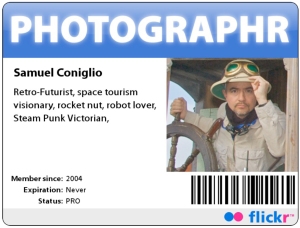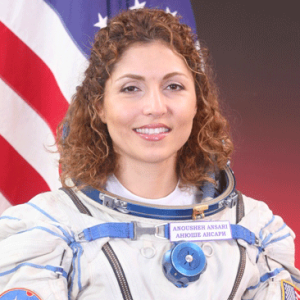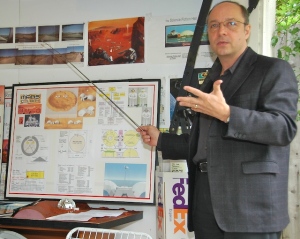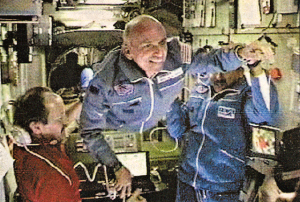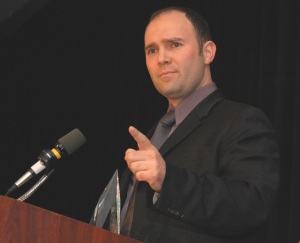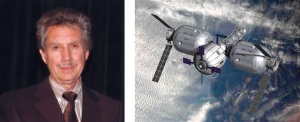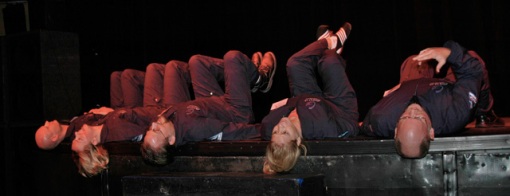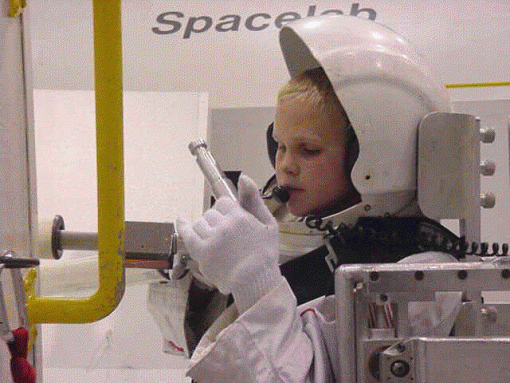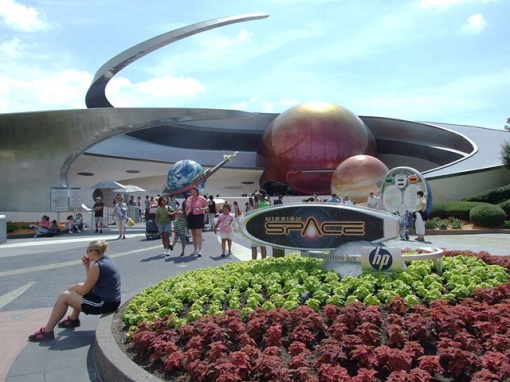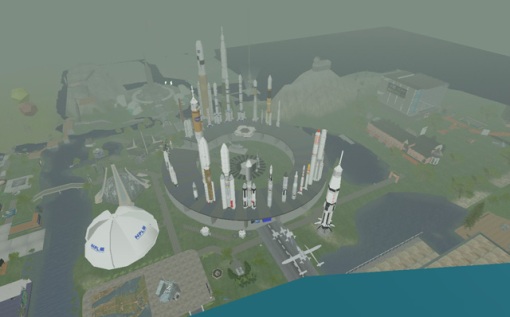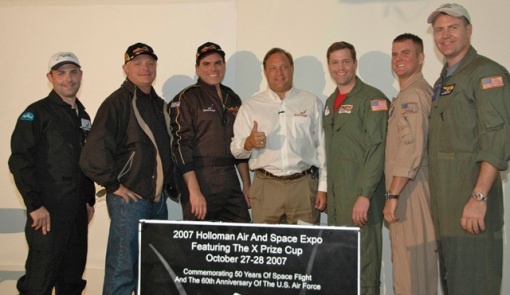Bureaucracies never die
This may be common knowledge for you folks, but just in case it ain’t…
This made me smile…
Michael Friedlander
The US standard railroad gauge (distance between the rails) is 4 feet, 8.5 inches. That’s an exceedingly odd number.
Why was that gauge used? Because that’s the way they built them in England, and English expatriates built the US railroads.
Why did the English build them like that? Because the first rail lines were built by the same people who built the pre-railroad tramways, and that’s the gauge they used.
Why did ‘they’ use that gauge then? Because the people who built the tramways used the same jigs and tools that they used for building wagons, which used that wheel spacing.
Why did the wagons have that particular odd wheel spacing? Well, if they tried to use any other spacing, the wagon wheels would break on some of the old, long distance roads in England, because that’s the spacing of the wheel ruts.
So who built those old rutted roads? Imperial Rome built the first long distance roads in Europe (and England) for their legions. The roads have been used ever since.
And the ruts in the roads? Roman war chariots formed the initial ruts, which everyone else had to match for fear of destroying their wagon wheels. Since the chariots were made for Imperial Rome, they were all alike in the matter of wheel spacing. Therefore the United States standard railroad gauge of 4 feet, 8.5 inches is derived from the original specifications for an Imperial Roman war chariot..
Bureaucracies live forever.
So the next time you are handed a specification/procedure/process and wonder ‘What horse’s ass came up with it?’, you may be exactly right.
Imperial Roman army chariots were made just wide enough to accommodate the rear ends of two war horses. (Two horse’s asses.)
When you see a Space Shuttle sitting on its launch pad, there are two big booster rockets attached to the sides of the main fuel tank. These are solid rocket boosters, or SRB’s. The SRB’s are made by Thiokol at their factory in Utah . The engineers who designed the SRB’s would have preferred to make them a bit fatter, but the SRB’s had to be shipped by train from the factory to the launch site. The railroad line from the factory happens to run through a tunnel in the mountains, and the SRB’s had to fit through that tunnel. The tunnel is slightly wider than the railroad track, and the railroad track, as you now know, is about as wide as two horses’ behinds.
So, a major Space Shuttle design feature of what is arguably the world’s most advanced transportation system was determined over two thousand years ago by the width of a horse’s ass. And you thought being a horse’s ass wasn’t important?
Ancient horse’s asses control almost everything…
END
Zachary’s Pizza
The greatest pizza ever! Serious Chicago-style. Thick crust, lots of tomato sauce.
Making solar power sexy
Here’s a very sexy commercial for space-based solar power:
Predicting the Rocket Future
Its 6:30 in the morning, when words flow like buttter….sort of.
Its been a busy week for the private space travel movement. Virgin Galactic unveils the White Knight two carrier plane , the first part of two part system for sending tourists into space. Then at the Oshkosh air show, XCOR Aerospace flew the Rocket Racing League’s first rocket powered aircraft. Finally SpaceX launched the Falcon 1 rocket. Unfortunately they had a second stage separation problem.
I am now convinced that the old multi-stage rocket method of getting into space is a royal pain in the ass and should be replaced. We know airplanes. We know how to fly really large and heavy things with them. We know how to drop something out of them. It just works. Even rocket powered airplanes are viable.
I was saddened to witness the anticipation and the failure of the Falcon 1. Friends and family were there at the SpaceX rocket factory, all ready for a good show. But delays kept postponing the launch. THe sadness in their eyes after the rocket’s failure, especially in Elon Musk’s, was heart-wrenching.
So let’s put my futurist hat on. I predict that Scaled Composites/Virgin Galactic will have a near monopoly in human space transportation for a few years. XCOR will be second, as they get more funding to build bigger, more reliable rocket powered aircraft. I would not be surprised that Scaled hired XCOR for a future generation Space Ship X vehicle to fly under a White Knight X. NASA, desperate to keep the space station going after the shuttle retires (they have already destroyed the repair facility in Palmdale, and are breaking down other infrastructure in other places), will at first waste another few billion taxpayer dollars on a human launch system, and fail. They will then consider Scaled/XCOR as a viable Plan B, since outside of the Russians, they are the only American game in town. This happens in less than 15 years.
Virgin Galactic will lease a habitat from Bigelow Aerospace to create the first true space hotel, albeit it will be more of a log cabin or a hostel in its first iteration.
It may take twenty years before a competitor appears to go up against Virgin/Scaled. Burt Rutan has 30 years aircraft experience to support him, and it will be hard to beat that fact.
Falcon 1 launches well, fails at second stage seperation

It was a bittersweet day at SpaceX. The private rocket company has high hopes with building cheaper and more reliable vehicles than its government-sponsored competitors. But like all rocket science, it IS rocket science, and that means complicated challenges to resolve.
 I was fortunate to be chosen to photograph the launch event at SpaceX’s rocket factory headquarters in Hawthorne, near Los Angeles LAX Airport. Tension was high in the flight control trailer as multiple delays in fueling and pressurization postponed the flight of Falcon 1 rocket.
I was fortunate to be chosen to photograph the launch event at SpaceX’s rocket factory headquarters in Hawthorne, near Los Angeles LAX Airport. Tension was high in the flight control trailer as multiple delays in fueling and pressurization postponed the flight of Falcon 1 rocket.
After several delays due to loading Helium pressurization. (cold gases on a very hot day in Kwajaleen), SpaceX finally went to countdown. The clock went to zero and nothing happened. Some computer alert stopped the launch 1/2 sec to go.
After a fifteen minute hold, the clock was cycled back to ten minutes. The countdown resumed, and the launch was perfect. The event was friends and family only. Myself and a videographer were the only media-like folks allowed to document the launch. The family members were really excited when the rocket flew. But the employees knew the show was not over. For about five minutes, the stage one firing was perfect. We saw the rocket cam images of the Earth falling away. Then second stage separation… and the video cut out. A minute of uncomfortable silence, then the SpaceX webcast hosts came online and and said something happened to the second stage separation. Ten minutes later Elon Musk walked out of the Command Trailer and to the front of the audience area.
He explained the rocket was lost. Three of the four separation bolts fired. The Second stage engine ignited while the first stage was still attached. You can guess the rest. Elon re-iterated that the failure does not stop flights 4 5 or 6. SpaceX received extra funding to guarantee it. Work continues.
There is a recovery ship tracking the GPS signals of the rocket stages. It will try to rescue the rocket when it crashes to the ocean.
These separation bolts have been used successfully a hundred times, one engineer said. So an investigation begins.
There was a lot of anticipation and high hopes yesterday. Things are pretty quiet now, but everyone is going back to work.
Friends and family were allowed at the event. No media. The exception was myself and a few other chosen videographers to record the event. The actual Falcon 1 rocket was 2100 miles away, on a sliver of land on the Kwajaleen Atoll, one of a series of US owned islands in the South Pacific.
Alternating between the audience, the makeshift media booth hosted by two telegenic members of SpaceX’s marketing team, and the flight control trailer, I got to see this amazing place in detail. A Rocket Factory!!! How cool is that? Falcon 1 rockets and mockups were on display or in various stages of construction. The massive tank that is the Falcon 9 first stage was so large, yet in this voluminous building the sense of scale was deceiving.
 The flight control trailer reminds me of another launch, and another trailer, fifteen years ago. This year is the anniversary of the Delta Clipper Experimental (DC-X) flights. For those who do not know of the DC-X, it was military-funded project to build a fully reusable rocket ship. It flew. Twelve times. Over three years (1993-1996). The success of the DC-X program inspired so many people and projects that the list boggles (the X PRIZE, Pioneer Rocketplane, Kistler Aerospace, Kelly Space, Rotary Rocket, XCOR Aerospace, Blue Origin, Armadillo Aerospace, Masten Space Systems, and TGV Rockets and so on.) A combination reunion of the DC-X team and a space conference is happening in Alamogordo, New Mexico in two weeks. Check out the DC-X Project website for details. I’ll be there… showing off my photos from DC-X Flight 8 mission.
The flight control trailer reminds me of another launch, and another trailer, fifteen years ago. This year is the anniversary of the Delta Clipper Experimental (DC-X) flights. For those who do not know of the DC-X, it was military-funded project to build a fully reusable rocket ship. It flew. Twelve times. Over three years (1993-1996). The success of the DC-X program inspired so many people and projects that the list boggles (the X PRIZE, Pioneer Rocketplane, Kistler Aerospace, Kelly Space, Rotary Rocket, XCOR Aerospace, Blue Origin, Armadillo Aerospace, Masten Space Systems, and TGV Rockets and so on.) A combination reunion of the DC-X team and a space conference is happening in Alamogordo, New Mexico in two weeks. Check out the DC-X Project website for details. I’ll be there… showing off my photos from DC-X Flight 8 mission.
One Huge Plane
I was able to briefly attend the rollout of Virgin Galactic’s new carrier aircraft, White Knight 2.
Here are my photos on flickr:
http://www.flickr.com/photos/spacemansam/sets/72157606433514833/
Richard Branson and Burt Rutan unveiled the new carrier plane for Space Ship Two. Called EVE, after Richard’s mother, this craft has a 140 foot wingspan, twin booms for carrying pilot, crew and guests, and four Pratt & Whitney PW308 engines. It is the largest carbon composite aircraft ever built.
After the rollout, I visited my friends Rich Pournelle and Henry Vanderbilt at XCOR Aerospace. Only a small crew was home. The rest were in Oshkosh for the world premiere of the Rocket Racing League rocketplane. Also visiting XCOR was Chris Gilman of Orbital Outfitters. XCOR has a contract to lease his new generation space suit when XCOR is ready to fly the Lynx, a sub-orbital rocket plane that will soon compete with Space Ship Two.
Competition is a good thing.
Robot Dreams
UPDATE: Here are links to the robot photos—
www.flickr.com/photos/spacemansam/sets/72157605630321847/
——-
So here I am in San Francisco, getting ready for my annual pilgrimage to RoboGames. For those of you who do not know, this is the premiere robot showcase on the West Coast. You can see the famous Battle bots duke it out in the bulletproof arena, where “sparks fly and robots die.”
Also, RoboGames presents soccer bots, fire fighting bots, bots that make drinks, and art bots. Art bots don’t do much, but they look cool.
RoboGames is an international endeavor. Teams from Brazil, the UK, Spain, meet with groups from Japan, Singapore, Hong Kong, South Korea, and Russia. They unite in their love of the machine.
Exotic bots such as Ziggy a six legged or hexapod bot come out to play.
Robogames is a popular event to bring the entire family. And it is perfect for Father’s Day, since tinkering with machines tends to be a guy thing (except in San Francisco).
Here’s my fake Badge for the show:
What the Heck is Space Tourism?
NOTE: This is one of several unpublished articles on Space Tourism that I am working on. I’m looking for feedback and opinions.
The classic film “2001: A Space Odyssey” exposed an amazed audience to a vision of the future that seemed possible. Released in 1968, at the height of the Space Race to the Moon, the public was ready to accept the potential reality of a Hilton Space Hotel in orbit around the Earth. They saw a Pan Am Space Clipper majestically sail into the Hotel’s docking bay. Passengers disembark like it was a ferry boat. At the time, the public was ready to accept this as a new reality.
Forty years later, the old feeling is back. Rich businessmen spend $20 million on a trip to the International Space Station. Adventure seekers get a taste of weightlessness in aircraft from Zero Gravity Corporation. The $10 million Ansari X Prize was awarded to a company which flew the first private spaceship. Tourists flock to NASA Space Centers, the National Air & Space Museum, and Science Centers to learn about space travel. Space is cool again.
So what does it all mean? Back in the 1960’s people saw the TV cartoon show “The Jetsons” and believed robot maids would be in every home, and we would be flying our personal rocket car to work. Today, the Roomba robot vacuum is a hot seller. The rocket cars, well, ain’t there yet. But a lot of folks are working on it.
In 2003, China became the third country outside of the United States and Russia to launch a man into space. They are also getting into the space tourism fray by adding a fourth launch site combined with a theme park.
Asia is coming of age, and having a space program is perceived as major prestige boost for each country. Singapore is developing a spaceport with the assistance of Space Adventures, the American company responsible for sending five tourists to the ISS. Malaysia is pondering how a Muslim in orbit can pray five times a day when the sun rises every 90 minutes. Japan is the most technologically advanced, especially in the realm of robotics. India has launched a long range rocket that they intend to send satellites into orbit, South Korea announced they too are developing a space program.
Photo Caption: Anousheh Ansari, the 4th private space traveler. Photo: NASA
It is international. When businesswoman Anousheh Ansari flew to the International Space Station on September 18, 2006, she wrote a daily blog about her personal experience. She wrote with such candor that it inspired a generation of women, especially women in the Middle East, that they can achieve their dreams.
Much of what the public knows about space tourism comes from the X PRIZE Foundation. The organization made history in 2004 when a company won the $10 million Ansari X PRIZE for sending a privately owned spaceship to the edge of space.
Space Tourism should be looked at in the context of the tourism industry as a whole. Tourism is the world’s largest industry, with revenues of $3 Trillion in 2000. One of the fastest growing sectors is adventure travel. Going to Disney World is fine for most people, but there are a some who want more. 50,000 people visit Antarctica every year. Hundreds of people attempt to climb Mount Everest, which is still a dangerous venture. Scuba diving has been a popular pastime since the 1950’s. These are treks for folks who want a physical challenge and seek a new, unique experience.
Photo Caption: John Spencer of the Space Tourism Society. Photo: Samuel Coniglio
The space tourism experience exists today and at many different levels. From attending space-theme rides, to flying in spaceship simulators, to training for the real thing, there are many adventures available, depending on your time and your budget. John Spencer, President of the Space Tourism Society, a non-profit group that is setting the long term vision of the industry, breaks down space tourism into five different levels: Real Space, Sub-Orbital Flights, Zero-Gravity Flights, Immersive Simulations, and Virtual Worlds.
Real Space
Traveling to space is an extension of the adventure travel experience. Like climbing Mt. Everest or scuba diving, it requires time, preparation, and physical fitness. Disposable income helps too. These travelers are a not a casual vacationer: they are serious. Currently the only destination is the International Space Station, but that will be changing soon.
Dennis Tito, the 1st private space traveler. Photo: NASA.
On April 28, 2001, Los Angeles businessman Dennis Tito flew to the International Space Station. He spent eight months of training in Russia, working beside cosmonauts Talgat Musabayev and Yuri Baturin. Despite immense controversy from NASA, including an incident where Mr. Tito was not allowed into the Johnson Space Center for ISS training, he did fly. This opened the doors for private space travelers and gave the struggling Russian space program a needed boost in revenue.
Eric Anderson of Space Adventures. Photo: Samuel Coniglio
Space Adventures is the premier space tourism company. Founded in 1992 by adventure travel enthusiasts and run by marketing wizard Eric Anderson, Space Adventures offers the full spectrum of space tourism adventure packages. From NASA space center tours guided by an astronaut, to zero gravity airplane flights, to MiG 29 fighter jet flights to the edge of space, and full cosmonaut training for the ultimate trip: a flight to the International Space Station. Starting with Dennis Tito, five wealthy adventurers from around the world have taken the ultimate journey. Space Adventures is also working with a Russian aerospace company to develop a sub-orbital passenger vehicle.
Photo Caption: L: Robert Bigelow. R: Computer image of his space hotel. Photos: Samuel Coniglio, Bigelow Aerospace
Robert Bigelow is a man with a vision. With two working prototype space hotels in orbit, his company Bigelow Aerospace is well on its way flying not just one, but a series of space habitats. A real estate developer by trade, Mr Bigelow made millions in the real estate market in Las Vegas, and also created the Budget Hotel Suites. Now he wants to lease the space habitats to national governments and to businesses.
Sub-Orbital Flights
The term “sub-orbital” means just below the altitude needed to stay suspended in space and cruising around the planet. The internationally recognized edge of the atmosphere is 62 miles/100 km. At that level, passengers experience about fifteen minutes of weightlessness.
L: Aviation legend Burt Rutan. R: SpaceShipOne tethered underneath carrier plane White Knight. Photos: Samuel Coniglio
On October 4, 2004 Space Ship One made the history books by being the first privately owned vehicle to carry a person to the edge of space. Designed by famous aviation designer Burt Rutan, his vehicle’s multiple flights proved to the world that private space travel was on its way. His company, Scaled Composites, is developing Space Ship Two as commercial venture with Virgin Galactic.
Richard Branson is an iconoclast. Famous his many entrepreneurial ventures under the Virgin brand name, his latest foray reaches for the stars. Virgin Galactic is a spaceline. You read that right, a spaceline.
L: Richard Branson. R: Mock-up of the interior of Space Ship Two. Photos: Samuel Coniglio, Virgin Galactic
Virgin Galactic is marketing Burt Rutan’s Space Ship Two for adventure rides to space. The spaceline operator has established a set payment of $200,000 per seat, with a minimum refundable deposit of $20,000 to make a reservation. As of July 2007, 200 customers from 30 different countries have already made deposits to confirm their reservations. The first commercial flights will be in the 2009-2010 timeframe.
Zero Gravity Flights
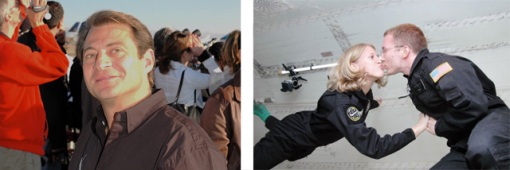
Photo Caption: L: Peter Diamandis of Zero Gravity Corporation, X PRIZE and many other space endeavors. R: A zero gravity kiss. Photos: L: Samuel Coniglio, R: Tim Bailey
Zero Gravity Corporation’s founder Peter Diamandis likes to call his company an “eleven year overnight success story.” It took a decade to get certification from the Federal Aviation Administration to allow flying of civilians in a simulated zero gravity environment. How do they do it? Specially outfitted 737 aircraft fly in parabolic arcs up and down at 35,000 feet altitude. On the way down, passengers experience weightlessness for about 30 seconds. Multiply that by about twenty parabolic arcs, you get the ultimate roller coaster ride. Special training helps reduce the chance for nausea, but not completely.
Immersive Simulations (resorts/adventures)
Photo Caption: The “Mars Improv” team prepares for “launch.” Photo: Samuel Coniglio
Red Planet Adventures is taking the Executive Training industry to another level. Using a trip to Mars as a theme, participants create a team, build a space ship, and define their mission. Along the way they learn about living in space from astronauts, scientists and other space experts. A comedy troupe called “Mars Improv” plays out each phase of the adventure based on participant suggestions. The whole program educates and promotes teamwork, all from a dinner-theater situation. No physical fitness or education requirements needed. And most of all, it is fun!
Photo Caption: A young astronaut builds a space station. Photo: Space Camp
SpaceCamp has been around since the 1982 as the premier training camp for kids and adults to become “astronauts.” It is located in Huntsville, Alabama, next to the NASA Marshall Space Flight Center. Thousands of children don flight suits and fly space shuttles in the camp’s giant simulator. The adult Aviation Challenge is also very popular.
Entrance to Mission:Space ride at Disney EPCOT Center. Photo: Wikipedia
Mission: SPACE is a motion simulator thrill ride at Epcot, a theme park at Walt Disney World Resort in Lake Buena Vista, Florida. It simulates what an astronaut might experience aboard a spacecraft on a mission to Mars, from the higher g-force of blastoff to the speculative hypersleep. Opened in 2003, the ride gives an amazing experience to 1,600 guests per hour!
Computer Sims / Virtual Worlds
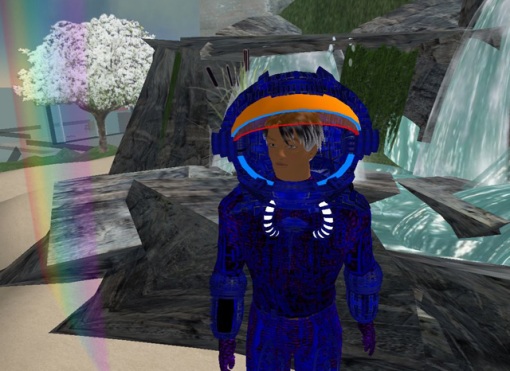
Photo Caption: The author’s avatar exploring a strange new world. Photo: Samuel Coniglio
Second Life recently became big news as part of the second generation Internet explosion. Beyond the web browser wars of the 1990’s, social networks like MySpace.com and Flickr.com are creating new types of communication. Second Life takes communication to the realm of science fiction. It looks like a computer game. You create a character called an Avatar, customize its appearance, and explore the Second Life world. You can build things and interact with other avatars. Unlike computer games, there is no end goal.
Photo Caption: View from the top of a virtual Vehicle Assembly Building at Second Life’s “Spaceport Alpha” island. Photo: Samuel Coniglio
NASA has a foothold in Second Life with the creation of CoLab or “Collaborative Laboratory.” This virtual lab is a joint effort by NASA and individuals to educate the public about space travel in new ways. Several non-profit organizations such as the National Space Society have dived into Second Life. On one of the “Islands” you can tour through a giant “rocket garden:” hundreds of replicas of rockets and space ships actually build and flown. Free classes teach avatar students physics and rocket science. Students can build and test new rocket designs all from the comfort of their own computer.
Photo Caption: Granger Whitelaw (center) co-founder of Rocket Racing League and the six rocket racer teams ready for action. Photo: Samuel Coniglio
The new Rocket Racing League is called the “NASCAR of rocket travel.” Six teams have been announced at the recent X PRIZE Cup, and all they are waiting for is the vehicle and a sports channel contract. In a nutshell, rocket-powered aircraft compete with each other in aerial racetracks that are visible in the pilot’s “Heads Up Display.” A unique feature of this technology is that viewers can participate via their computer. Using flight simulator software, participants can directly compete with the pilots with virtual rocketplanes. The real rocketplanes are being built by XCOR Aerospace in Mojave, California, home to many pioneer rocket companies. XCOR has created safe, reusable rocket engines that can be quickly refueled. Real world racing meets virtual racing.
Space tourism is more than drinking a martini in a space hotel. Space-related tourism adventures are available now for people of many economic levels. Like the barnstorming days of airplanes, it took many years of technology upgrades and new economic models like the airline industry to develop. We are in the early days of a new era, and our grandkids will take it for granted they can vacation on the Moon.
Evolution of Steampunk
It is very interesting to witness the evolution of a new social movement. The steampunk kids are just discovering each other, and all sorts of social/technological/fashionable things are happening.
Katherine and I went to see Abney Park, disputably one of the first “Steampunk-style” bands, on Sunday. They played at the Edison, an amazing high class bar in downtown LA. It originally was the first electric power plant in LA. Check out both web sites:
http://www.edisondowntown.com/
BTW, Absinthe is now legal in the USA. It will mess you up. I’m still recovering from Sunday.
The Neverwas Haul and Makers Faire

DSC_0406, originally uploaded by Spaceman Spiffy.
The Maker Faire was an amazing gathering of DIY (Do It Yourself) inventors, artists, and cool people. A strong showing from the local Burning Man scene made the event look like a BM technology fair. I was on the crew of the Neverwas Haul, a fantasy Victorian house on Wheels.
Check out this great video on Youtube about the event.:
-
Archives
- May 2009 (1)
- January 2009 (1)
- August 2008 (3)
- July 2008 (1)
- June 2008 (1)
- May 2008 (6)
-
Categories
-
RSS
Entries RSS
Comments RSS



